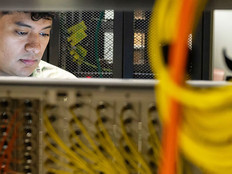DOD Embraces Virtual Desktop Infrastructure
Air Force bases are especially interested in virtual desktop infrastructure, a likely topic for discussion at the symposium, Dusin adds.
While VDI gained popularity in the commercial world more than a decade ago, the military is just figuring out how to securely implement the capability by logging into a virtual machine on a core server somewhere within the customer’s environment.
Historically, the Air Force bought all personnel computers with common access card readers for signing into different portals and websites and downloading updates. VDI offers bases advantages, saving users precious minutes every day logging into programs and databases, reducing access time to many applications and providing a secure environment that data never has to leave.
Virtual server environments are also easy to port to Microsoft Azure, Amazon Web Services and Google Cloud.
“The DOD wants to get away from building data centers and really focus on consolidation, moving what makes sense to the cloud and doing things more as a service,” Dusin says.
EXPLORE: These new threat metrics can help improve federal cybersecurity.
Buying Into Commercial Solutions for Classified
The Pentagon is also interested in secure cyber solutions leveraging commercial technologies and products, so Commercial Solutions for Classified is a term that will likely come up early and often at RMCS23, Dusin says.
CSfC provides National Security Agency-level certification that a particular mix of technologies is secure and trusted, allowing users to gain access to multiple networks (classified or unclassified) through end-user devices.
CDW•G is one of 83 vendors on the NSA’s Trusted Integrator List that can provide solutions to DOD. CDW•G also has done some CSfC work with the Army and Marine Corps, and is working to expand this portfolio to Space Force and Air Force units.
“We’ve done the IT work for all of those different things so DOD can stay plugged into its zero-trust environment without issues and get the mission done with the right IT,” Dusin says. “Everybody claims that they want CSfC, but everybody is scared of it.”
Picture a field operative with a tablet containing intelligence on a surveillance target being supported by drones overhead. Without CSfC, the surveillance captured by the drone is sent back to one network for analysts, while its captured intelligence must be downloaded to a secure IT environment before it can be analyzed and shared.
That’s no help to the operative, who may not have been at a secure facility for days. CSfC allows for classified information to be shared to trusted devices outside such sites, potentially providing the operative with relevant intelligence faster.
“We’re putting real-time military intel in the hands of that operative via that tablet when he or she needs it, and a solid CSfC solution means they can trust the intel,” Dusin says.
CSfC solutions are customized, multimillion-dollar projects that generally take between 13 and 18 months to implement.
Click the banner to access exclusive content on government tech by becoming an Insider.












